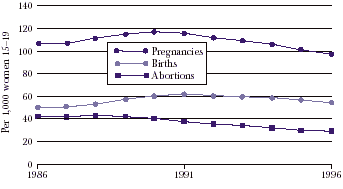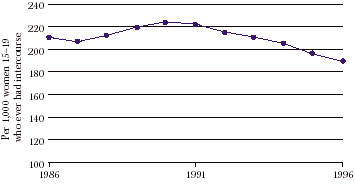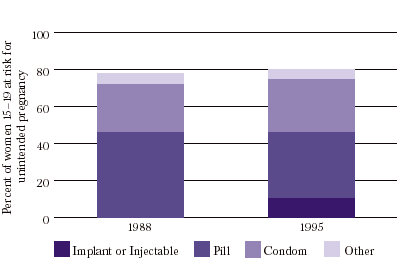New data demonstrate the continuation of a heartening trend: Teenage pregnancy rates, birthrates and abortion rates are falling. Between 1995 and 1996, the national teen pregnancy rate fell 4%, to 97.3 pregnancies per 1,000 women aged 15-19, contributing to a 17% decline since the rate peaked in 1990. Birthrates and abortion rates fell during the same time period; in 1996, the teen birthrate was down 12% since it peaked in 1991, and the teen abortion rate had dropped 31% since 1986 (see chart).
| Positive Trends |
| Teen pregnancy rates, birthrates and abortion rates have declined in recent years. |
 |
Pregnancy declines have been experienced by various teen cohorts. Rates decreased for younger teens as well as older teens during the first half of this decade. Similarly, the trend held true for black as well as for white teens, with black teens experiencing the larger drop, 20%, between 1990 and 1996. Among Hispanic teens, however, pregnancy rates rose between 1990 and 1992, and then fell off slightly.
Declines have also occurred throughout the country: Pregnancy rates were lower in 1996 than in 1992 for every state except New Jersey, where the rate was the same in both years. However, state rates vary widely—ranging from 50 pregnancies per 1,000 15-19-year-old women in North Dakota to 140 in Nevada (see table).
| Teen Pregnancy Rates, Birthrates And Abortion Rates, 1996 | |||
|---|---|---|---|
| State | Pregnancy rates | Birthrates | Abortion rates |
| United States | 97 | 54 | 29 |
| Alabama | 106 | 69 | 21 |
| Alaska | 75 | 46 | 18 |
| Arizona | 118 | 74 | 27 |
| Arkansas | 108 | 75 | 16 |
| California* | 125 | 63 | 45 |
| Colorado | 90 | 50 | 28 |
| Connecticut | 86 | 37 | 37 |
| Delaware* | 95 | 57 | 24 |
| Dist. of Columbia | 256 | 102 | 121 |
| Florida* | 115 | 59 | 40 |
| Georgia | 109 | 68 | 25 |
| Hawaii | 101 | 48 | 39 |
| Idaho | 70 | 47 | 12 |
| Illinois | 106 | 57 | 34 |
| Indiana | 88 | 56 | 19 |
| Iowa* | 58 | 38 | 12 |
| Kansas | 79 | 50 | 18 |
| Kentucky | 89 | 61 | 14 |
| Louisiana | 97 | 67 | 15 |
| Maine | 57 | 31 | 18 |
| Maryland | 106 | 46 | 46 |
| Massachusetts | 79 | 32 | 37 |
| Michigan | 87 | 46 | 29 |
| Minnesota | 56 | 32 | 16 |
| Mississippi | 108 | 75 | 16 |
| Missouri | 86 | 54 | 19 |
| Montana | 65 | 39 | 17 |
| Nebraska | 62 | 39 | 14 |
| Nevada | 140 | 70 | 51 |
| New Hampshire* | 57 | 29 | 20 |
| New Jersey | 97 | 35 | 50 |
| New Mexico | 110 | 71 | 22 |
| New York | 108 | 42 | 53 |
| North Carolina | 105 | 63 | 26 |
| North Dakota | 50 | 32 | 10 |
| Ohio | 81 | 50 | 18 |
| Oklahoma* | 90 | 63 | 13 |
| Oregon | 90 | 51 | 26 |
| Pennsylvania | 70 | 39 | 20 |
| Rhode Island | 87 | 42 | 32 |
| South Carolina | 98 | 63 | 20 |
| South Dakota | 59 | 39 | 10 |
| Tennessee | 100 | 66 | 18 |
| Texas | 113 | 73 | 23 |
| Utah | 60 | 43 | 8 |
| Vermont | 60 | 30 | 22 |
| Virginia | 87 | 46 | 30 |
| Washington | 85 | 45 | 29 |
| West Virginia | 73 | 50 | 11 |
| Wisconsin | 61 | 37 | 15 |
| Wyoming | 74 | 44 | 20 |
| *Abortion estimates are based on the proportion of abortions obtained by women of the same age in neighboring or similar states. Notes: Rates are per 1,000 women aged 15-19. Pregnancy rates include estimated number of pregnancies ending in miscarriages. Data are tabulated according to woman's age at the pregnancy outcome. | |||
This new information is certainly welcome news, but the challenges around teen pregnancy persist. Annually in this country, almost one million pregnancies occur among 15-19-year-old women, and the United States has one of the highest teen pregnancy rates of any industrialized nation. Clearly, sustaining the downward teen pregnancy trend is critical to the well-being of adolescents and the nation as a whole. Fortunately, information on why the rates are falling can help guide policymakers who are serious about doing so.
Questions and Answers
Until recently, explanations for the drop in teen pregnancy rates have been largely speculative. Some organizations have been quick to attribute the declines to increased abstinence among teenagers. Among them is the Consortium of State Physicians Resource Councils, which released a report earlier this year concluding that "the evidence points to sexual abstinence, not increased contraceptive use, as the primary reason for the decline in teen pregnancy and birth rates throughout the 1990s." The report highlighted the fact that there has been a slight decrease or leveling off in the proportion of 15-19-year-olds who have ever engaged in sexual activity. However, the report, which had serious methodological flaws, incorrectly concluded that these decreases accounted for the bulk of the decline in overall teen pregnancy rates.
Analyses by The Alan Guttmacher Institute (AGI) of the 1988 and 1995 National Surveys of Family Growth (NSFG)—the major source of government data on population and reproductive health—and other published studies demonstrate that the lion's share of the decrease in overall teen pregnancy rates is due to lower pregnancy rates among sexually experienced teens. Between 1990 and 1996, the rate among sexually experienced teens fell 16%—from 224 to 190 pregnancies per 1,000 women aged 15-19 (see chart).
| Not Just Abstinence |
| Pregnancy rates declined steeply in recent years among sexually experienced teens. |
 |
Declining pregnancy rates among sexually experienced teens must reflect one or more of three factors: less frequent intercourse, more overall contraceptive use or more effective contraceptive use.
NSFG data do not bear out a substantial decrease in the level of sexual activity among sexually experienced teens. Although a somewhat lower proportion of sexually experienced young women reported having had intercourse in the three months prior to the NSFG in 1995 than in 1988, these teens also reported having had sexual intercourse during the same average number of months in the 12 months prior to the two surveys.
Several measures of the NSFG do, however, demonstrate both somewhat increased and significantly more effective contraceptive use among sexually active teens. First, between 1988 and 1995, there was a small increase—from 78% to 80%—in the proportion of sexually active teenage women who reported currently using a contraceptive.
In addition, there is evidence that the overall effectiveness of teens' contraceptive use grew; average first-year failure rates were slightly lower in 1995 than in 1988. This is primarily because there was a substantial move among teen contraceptors toward use of highly effective, long-acting contraceptive methods—the contraceptive injectable, Depo-Provera, and the implant, Norplant. Neither method was available in the United States in 1988, but by 1995, one in 10 sexually active teen women at risk of unintended pregnancy were using one of these methods. The adoption of these new methods accompanied a substantial decrease in pill use and a slight increase in condom use. On balance, the use of the implant and injectable represents more a shift in contraceptive use than an overall increase (see chart). Because the failure rates for the long-acting methods are so low, however, this shift appears to be having a large impact on overall teen pregnancy rates.
| A Significant Shift |
| Many teens are using long-acting contraceptives. |
 |
Indeed, use of the implant and the injectable may have played a particularly large role in reducing second pregnancies among teen mothers. Data released earlier this year by the National Center for Health Statistics (NCHS) showed a dramatic 21% decline between 1991 and 1996 in the proportion of teens giving birth a second time. At the same time, NCHS researchers have pointed out, a relatively high proportion of teen mothers—one in four—are using long-acting methods.
The AGI analysis concludes that about 80% of the decline in overall teenage pregnancy rates since the late 1980s reflects this improved contraceptive use among sexually active teenagers. At the same time, it also confirms a decline—or, at least, a leveling off—in the proportion of teenagers who have ever had sexual intercourse. Between 1988 and 1995, the proportion of teenage women 15-19 who said they had ever had sex dropped one percentage point, from 52.6% to 51.5%. About 20% of the decline in the overall teen pregnancy rate is attributable to this increased abstinence.
It remains unclear what is motivating teens to use more effective contraceptive methods and to delay sexual activity.
Experts have speculated that a variety of factors may be at play, including the improved economy, fear of AIDS and changing attitudes about sex and childbearing. Whatever the underlying causes may be, clearly, for sexually active teens, access to a range of contraceptive methods—including the newest contraceptive technologies—has been critical to avoiding pregnancy.
Minors' Access Under Attack
Ironically, however, this news about improved contraceptive use by teens comes at a time of intensified attacks by conservatives in Congress on minors' access to contraceptives through key public health programs, particularly Title X. When Title X of the Public Health Service Act was enacted in 1970—creating for the first time a comprehensive federal program devoted entirely to the provision of family planning services on a national basis—policymakers' goals were severalfold. Among their primary concerns were high rates of unwanted childbearing among low-income women. But Title X was also created with an eye toward addressing increasing rates of teenage pregnancy and too-early childbearing. As a result, Title X was designed specifically to provide high- quality, confidential services to all women who request them—without regard to age or marital status.
Since the program's inception, hundreds of thousands of teens have turned to Title X clinics for family planning services—for contraceptive care as well as for sexually transmitted disease testing and treatment, cancer screening and gynecologic care. In 1994 alone, clinics supported by Title X and other public health programs served nearly two million teenage women—an estimated 40% of all teenagers who are sexually active and in need of services. Clearly, the policy of confidentiality for all women seeking services has enabled Title X clinics to meet adolescents' special needs.
However, it is this very policy that conservative activists want to reverse. In 1998, for the third year in a row, a small but powerful cohort in Congress attempted to impose a parental notification requirement for minors seeking family planning services at Title X clinics. In 1996 and 1997, their efforts failed in the House, but in 1998, a provision requiring Title X clinics to notify a parent at least five days prior to providing a contraceptive to a minor was endorsed by a House committee and then by the full House. The provision was later dropped during final negotiations with the Senate and the Clinton administration, but its supporters are already gearing up for another attempt this year.
Proponents of mandatory parental involvement claim that providing confidential services is tantamount to condoning sexual activity, and that parental notification is necessary to encourage abstinence and foster parent-child communication. However, proponents' claims that mandated parental involvement could result in increased abstinence and improved family relationships are supported neither by research nor by providers' experiences.
Teens and the Need for Confidentiality
Research has confirmed that requiring parental consent or notification may have the unintended effect of deterring some teens from seeking services. In a 1993 study published in The Journal of the American Medical Association (JAMA), 64% of high school girls said that there are some health concerns that they would not want their parents to know about, and 29% of girls answered yes to the question, "Would you ever not go for health care because your parents might find out?" The JAMA study echoed the conclusion of a 1983 study published in The Journal of Pediatrics, in which the researchers found that a majority of high school students would not be willing to seek care related to sexuality, substance abuse or emotional upset with their parents' knowledge.
A 1981 study published in Family Planning Perspectives involved a survey of over 1,200 teen women at the time of their first contraceptive visit to a family planning clinic. Among the study's chief findings was that many teen women delayed seeking family planning services until months after initiating sexual activity; the median delay reported was one year. (Only 14% of teens surveyed said they were visiting a clinic before engaging in intercourse.) The young women cited fear their parents would find out about the clinic visit as a major reason for delaying. Moreover, more than one-third of the teens said they were making their first family planning visit because they suspected they were pregnant.
In an effort to address these unique health concerns, key medical associations and public health organizations have long recognized confidentiality as critical to serving adolescents—with many groups adopting official positions to this end. For example, the Society for Adolescent Medicine maintains that "contraceptive education, counseling, and services should be made available to all male and female adolescents desiring such care on the adolescents' own consent without legal or financial barriers. Parental involvement should be encouraged, but this should not be required through either consent or notification." Similarly, a group of medical organizations, among them the American Academy of Pediatrics and the American Academy of Family Physicians, endorsed a position paper stating that "adolescents tend to underutilize existing health care resources. The issue of confidentiality has been identified, by both providers and young people themselves, as a significant barrier to health care." These groups have urged their members to make "every reasonable effort to encourage the adolescent to involve parents," while also affirming the importance of confidentiality in the provider-adolescent patient relationship.
Public Policy Implications
Even the very conservative activists who are targeting minors' access to confidential family planning services acknowledge that requiring parental consent or notification will discourage teens from seeking services. In last year's floor debate over mandating parental involvement for teens seeking contraceptive services from Title X-funded clinics, Rep. Tom Coburn (R-OK) said in no uncertain terms that he agreed with opponents of the notification mandate that "there will be young women who will choose not to go"; he even went so far as to acknowledge that "if we put in the [parental notice language], some additional young women will get pregnant; some will get a sexually transmitted disease." But he and like-minded members of Congress apparently reason that it is worth deterring "some" teens—however many that might be—from services in order to pursue their agenda for social change: that is, using parental involvement laws and strict "abstinence-only" programs to drive teens away from sexual activity altogether. Indeed, many of the same members of Congress who are leading the parental involvement effort also spearheaded the massive infusion of federal and state money into abstinence-only programs under the auspices of the 1996 welfare reform law.
This strategy has recently gained political momentum, despite the fact that it raises a number of critical questions. Among them: Where would mandated parental involvement and abstinence-only policies leave the many teens—fully half of all 15-19-year-olds—who are currently sexually active? How many sexually active minors would not seek services if confronted with a parental involvement mandate? And, furthermore, how can abstinence best be promoted? There is still no scientific evidence showing that the politically popular abstinence-only programs have any impact on teenage sexual behavior.
The questions underlying this strategy may be even more troublesome in light of the newly available teen pregnancy data—from which a primary conclusion must be that improved contraceptive use can make, and is making, a big difference. To sustain the downward trends in teen pregnancy rates, it will be necessary, even if politically difficult, to integrate that conclusion into policies and programs. In that way, even as teens are encouraged and fully supported in their efforts to delay the onset of sexual activity, society also will be supporting in every way possible sexually active teens who want to avoid pregnancy—and appear to be getting better at it every year.

